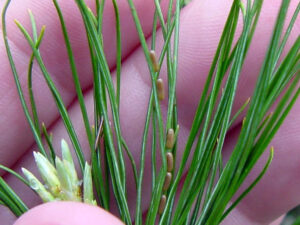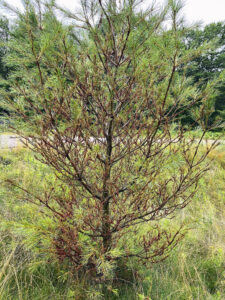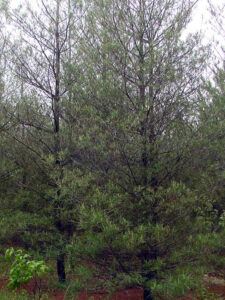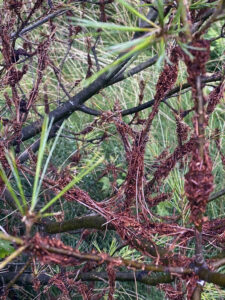
A closeup photo shows that pine false webworm eggs look like a string of sausages, displayed here on a white pine needle. / Photo Credit: Liunda Williams, Wisconsin DNR
By Linda Williams, DNR Forest Health Specialist, Woodruff;
Linda.Williams@wisconsin.gov or 920-360-0665
Pine false webworm (Acantholyda erythrocephala) is not a very common insect in Wisconsin, but damage from larval feeding can occasionally be seen. The insects prefer to feed on white pine in Wisconsin, although reference material says they will also feed on red pine, jack pine and scotch pine.
Damage was reported as minor in the central part of the state from 1953 to 1961. In 1995, 1997, 2002, 2004 and 2006, it was once again observed as a minor pest feeding on red or white pine in the central part of the state, particularly Portage, Waupaca and Waushara counties. In 2024, a few scattered young white pine trees in Oneida and Vilas counties were observed with significant defoliation.

A young white pine tree defoliated by pine false webworm. The invasive pest eats the tree’s old needles. / Photo Credit: Linda Williams, Wisconsin DNR
Pine false webworm is not a native insect to North America. It was accidentally introduced into the United States in 1925. No widespread outbreaks have been reported in Wisconsin.
Adult webworms resemble wasps and emerge in the spring to mate and lay eggs on the needles of a nearby pine tree. They prefer younger trees, typically 5-20 feet tall. Larvae feed on old needles, creating lots of webbing that traps bits of needles and frass, leaving a messy, defoliated tree. Mature larvae drop to the ground and burrow into the ground, overwintering as a pre-pupa, which will complete pupation in the spring before emerging as an adult.
An article in Canadian Entomologist noted that the proportion of pre-pupae remaining in the soil for more than one year varied from 9% to 66% between two sites in the state of New York. That may account for the every-other-year reports from 2002 to 2006. However, formal surveys for this insect have not been performed in Wisconsin, so the lack of reporting may have been coincidental.

White pine trees, defoliated the previous year by pine false webworm, appear thin as the new growing season progresses. / Photo Credit: Linda Williams, Wisconsin DNR
By the time most people notice the defoliation, the damage has been done for the year, and no control is necessary. However, monitoring the following spring will help you decide if pesticide treatments are required. Sawfly larvae are not true caterpillars, so Btk insecticide products do not work – a different pesticide will be needed. Some work has been done looking at applications of a virus that affects the larvae (NeabNPV), with mixed results. In 2002-2004, a tachinid fly (Myxexoristops hertingi) from the native range of pine false webworm was released in Ontario, Canada, to try to combat the webworm.

A pine false webworm infestation shows messy webbing, with bits of dead needles and lots of frass, to indicate feeding by the invasive insect. / Photo Credit: Linda Williams, Wisconsin DNR
